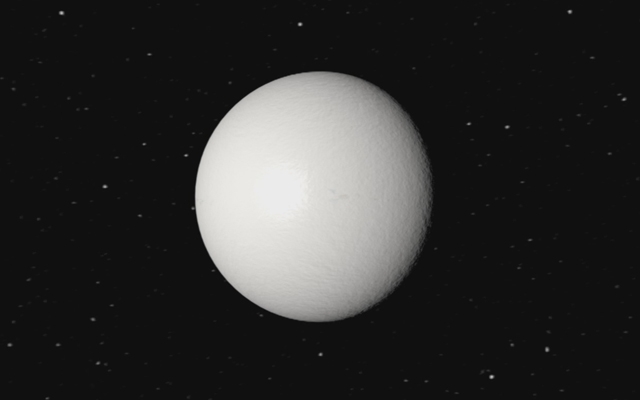
全球凍結
Snowball earth
いつの時代においても寒冷化は生物の繁栄を妨げる深刻な現象である。寒冷化が進むと厚い氷の塊が大陸を覆うようになり、生物の多様性は大きく減少してしまう。実は、地球は規模の大きな寒冷化を繰り返し経験してきた。中でも原生代には、地球生命体の存続を根本から揺るがしてしまうほどの深刻な寒冷化、全球凍結と呼ばれる現象が起きていた。
全球凍結とは地球の表層の全てが凍り付いてしまう現象である。現在では陸上の限られた地域にしか厚い氷の塊は存在しない。高い山の頂上付近に発達する山岳氷河の、緯度の高いグリーンランドや南極に存在する大陸氷床である。しかし、全球凍結イベントの発生時には緯度の低い赤道にまで大陸氷床が張り出し、地球全体がまるで雪玉の様な状態になってしまった。この全球凍結イベントは、原生代の約25〜21億年前(ヒューロニアン氷期)と約7億3000〜7億年前(スターチアン氷期)、6億6500〜6億3500年前(マリノアン氷期)の3回起きたことが知られている。
いったん全球凍結が起きると陸はおろか海も全て凍り付いてしまい、光の届くところに液体の水はほとんど存在しない。生物は水が無ければ生きてゆけず、多くの場合光も必要である。では、生物はどこで生きながらえたのであろうか? 外部からの物質を必要としない独立した生態系が存在する海底熱水噴出孔や、火山地域の温泉であった可能性が考えられる。しかし、詳しいことはまだよく分かっていない。
地球が全球凍結から回復することは思いのほか困難だったようである。現在の地球は太陽光を吸収することで暖められているが、全球凍結時に地球の表層を覆った氷は太陽光を反射してしまい、気温がますます低下してしまったのである。回復への糸口は地球の内部にあった。地球の表面は凍り付いても内部のマントル対流は依然として活発だったのである。火山活動によって地球の内部から外部へと徐々に放出された二酸化炭素は、温室効果によって地球の表層を暖めて全球凍結からの回復を促した。氷が溶けて光が降り注ぐようになった海、そこには生物大飛躍のチャンスが待っていた(☞8ページ)。
At any age, Earth cooling has always been a hindering phenomenon to living organisms' prosperity. Indeed, as the cooling process progresses, ice covers the continent, and the biodiversity decreases greatly. In fact, the Earth has experienced repeatedly large-scale cooling events during its History. However, among all these entire large-scale cooling events, no one was as close as destroying Earth life than the Proterozoic glaciation phenomenon also known as the "snowball earth" hypothesis.
The term “snowball earth” refers to the hypothesis that during the Proterozoic, Earth's weather was so cold that all Earth's surface was covered in ice. Currently, the ice sheet is only limited to continental areas but what is an ice sheet? It is a mass of glacier ice formed near the top of a high mountain and that covers the surrounding terrain. It is currently covering the high latitudinal Greenland and Antarctica. But when the glaciation event occurred during the Proterozoic eon, the continental ice sheet extended from earth's geographical poles to the equator, making the whole Earth white like a snowball.
In total, 3 glaciation events occurred during the Proterozoic:
- The Huronian glaciation (2.5 to 2.1 billion years ago),
- the Sturtian glaciation (730 to 700 million years ago),
- the Marinoan glaciation (665 to 635 million years ago).
Once the glaciation began, all seas and lands were frozen in the process, leaving no liquid water for the sunlight to reach. Generally, living organisms cannot survive without water and in many cases without light. Then, where did those organisms live? It is thought that life on earth may had been able to survive thanks to independent ecosystems, that do not require external substances, living near submarine hydrothermal vents and inside volcanic area's hot spring. But details are not well understood yet.
It seems that Earth recovery from the global glaciations was unexpectedly difficult. Currently Earth is warmed by the sunlight it absorbs. However when the ice covered the whole surface of the Earth during the glaciation, the ice reflected the sunlight, which led to lower and lower temperatures. Clues to this unexpectedly difficult recovery were to be found inside the Earth. Indeed, even if the surface of the Earth was frozen, the internal mantle convection was still active. The Earth's internal volcanic activity created carbon dioxide that once released in the atmosphere prompted the warming of the surface by greenhouse effect. The ice started to melt and the light began to fall down to the bottom of the ocean. It was the chance life was waiting for (☞ page 8).